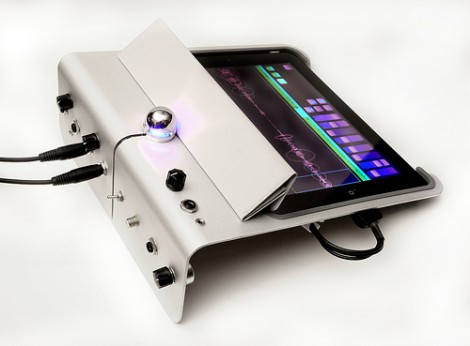
You can buy nice audio breakout equipment for your iPod if you don’t mind breaking the bank. This is partly because the demand is not incredibly high so commercial breakout hardware doesn’t benefit from volume discounts. But it’s also because Apple charges licensing fees for third-party accessories (often referred to as the “Apple Tax”). [Reed Ghazala] decided to side-step the whole situation by building his own accessory which he calls the iPad Audio Desk.
It all starts with a breakout board. The PodBreakout Mini provides an easy to solder interface for the iPad, and ensures that the repetitive act of plugging and unplugging the connection doesn’t break a solder connection. From there [Reed’s] enclosure finishing skills take over. The shape and curve of the aluminum sheet give the look befitting an expensive tablet device. Along the back you can see the jacks for line-in, line-out, video, mic/guitar, and headphones that make the dock useful. It wouldn’t be hard to make one… but it might be hard to make one look this great. See for yourself after the break.
[youtube=http://www.youtube.com/watch?v=hgZer4_CKwQ&w=470]















“The shape and curve of the aluminum sheet give the look befitting an expensive tablet device.”
So all it takes to look like an expensive tablet is a piece of press braked aluminum :) ?
It does look quite good actually.
I was under the impression that Apple only ‘taxed’ the dock connector, requiring a licensing fee to use it, which I’m guessing Kineteka paid for the pod breakout mini.
Certainly a well done piece of kit, just not sure about the licensing costs being a factor for the high cost of commercial units, probably mostly the items from the first sentence (lack of volume sales.)
Looking at the video, at 4:50 you can see that it seems that he kind of missed the point of using a breakout connector. He solders 30 AWG wire to the fingers of the connector and then routes the wire through the holes in the PCB for strain relief.
@ducksauz
thats because pin n° 11 isn’t connected on the mini breakout..(only 1, 3, 4, 5, 6, 8, 13, 12, 21, 23, 25, 27 and 30 are connected on the mini)
Love the 1 night work, turns out very nice (i imagine that your program/app took a bit more time)
Just to add some credibility to the hack, the creator is *the* Reed Ghazala, the inventor/discoverer of circuit bending.
@soward
The parts you would need from Apple are their security coprocessor and dock connector ($2). In addition to this, there is a $5 royalty taken from every product.
Additionally you will also need to be a corporation which is MFI licensed. Becoming MFI licensed entails having a website, product plan and sales forecast. While possible for a DIYer to do all this most probably won’t want to step through these hoops.
+1 for modifying an existing accessory.
@sky I am sure lots of other people “invented” circuit bending. What you mean to say is coined the term or popularized.
Is it okay that it makes me sad that Reed Ghazala owns an iPad?
Or you could just use the Android Accessory kit, avoiding any licensing costs. =)
But then you’d have to use android – pass.
This is interesting, but:
A) The line in on the iPad, iPad2, iPhone 4 is not in the pin layout anymore. Check out Sonoma Wireworks GuitarJack. It was designed for the line in, but since then, they’ve had to completely redesign it because Apple changed the pin layout.
B) Hooking a guitar directly into the headphone jack is not a good idea. Attempting to change your guitar gain or switch pickups, will signal the iPad to do things like start playing music. PRS came out with a cheap cable which was just a connector interface, but it was rife with problems and feedback. Better to get an Peavy AmpKit, which has a JFET which does some management of the signals. It also will manage the cross-talk so you don’t kill your ears with feedback.
C) Finally, there is plenty of line level noise and crosstalk from these devices on the analog route. A better bet is to take advantage of the iPad’s USB audio capabilities using the camera connection kit. It will give you digital access to two input/output channels.
@CG interesting idea.
CG- could you maybe give me a nudge in the right direction regarding the USB connection for audio processing? I was just getting set to build this, but the USB connection is a far more compelling idea than the breakout board.
Have you investigated if any programs such as Garageband can take advantage of USB audio in via USB?
I am going to start on the investigations in earnest tomorrow but a little help getting there is always appreciated.
@CG you can use USB, as long as you enroll in Apple’s MFI program otherwise the device will not even communicate with you. Sad but true.
Apple has all their devices completely locked down. They and only they want to be able to decide who makes peripherals and accessories for them.
One way to get arbitrary data into your ipad would be to buy a midi interface designed for ipad then send MIDI data as a SySex dump.